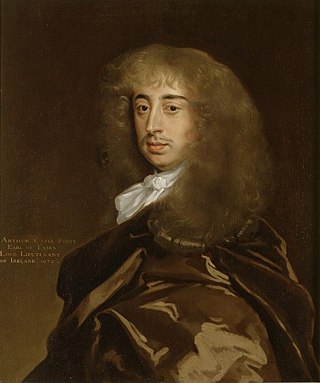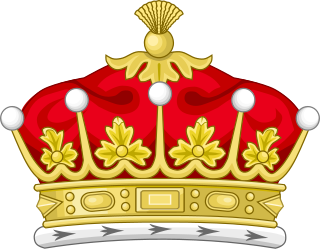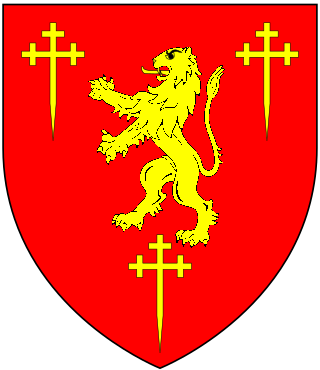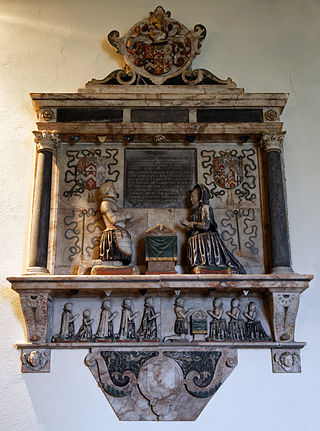Related Research Articles

Arthur Capell, 1st Earl of Essex, also spelt Capel, of Cassiobury House, Watford, Hertfordshire, was an English statesman.

Earl of Essex is a title in the Peerage of England which was first created in the 12th century by King Stephen of England. The title has been recreated eight times from its original inception, beginning with a new first Earl upon each new creation. The most well-known Earls of Essex were Thomas Cromwell, chief minister to King Henry VIII, Sir William Parr (1513-1571) who was brother to Queen Catherine Parr who was the sixth wife of King Henry VIII, and Robert Devereux, 2nd Earl of Essex (1565–1601), a favourite of Queen Elizabeth I who led Essex's Rebellion in 1601.

Henry Capell, Baron Capell of Tewkesbury KB, PC was an English politician who sat in the House of Commons between 1660 and 1692. He was then created Baron Capell.

Sir William Capel of Capel Court in the parish of St Bartholomew-by-the-Exchange in the City of London and of Hadham Hall in the parish of Little Hadham, Hertfordshire, served as Lord Mayor of London and as a Member of Parliament for the City of London.

Arthur Capell, 1st Baron Capell of Hadham, of Hadham Hall and Cassiobury House, Watford, both in Hertfordshire, was an English politician who sat in the House of Commons from 1640 until 1641 when he was raised to the peerage as Baron Capell. He supported the Royalist cause in the Civil War and was executed on the orders of parliament in 1649.

William Capell, 3rd Earl of Essex, was an English courtier and diplomat.

Little Hadham is a village and civil parish in the district of East Hertfordshire, Hertfordshire, England. At the census of 2001 it had a population of 1,081, increasing to 1,153 at the 2011 Census. It is bypassed by the A120 road, which connects it to the nearby town of Bishop's Stortford. The civil parish includes the hamlets of Bury Green, Church End, Cradle End, Green Street and Hadham Ford. Little Hadham, together with the neighbouring village of Much Hadham, are collectively known as The Hadhams.

Cassiobury Park is the principal public park in Watford, Hertfordshire, in England. It was created in 1909 from the purchase by Watford Borough Council of part of the estate of the Earls of Essex around Cassiobury House which was subsequently demolished in 1927. It comprises over 190 acres (77 ha) and extends from the A412 Rickmansworth Road in the east to the Grand Union Canal in the west, and lies to the south of the Watford suburb of Cassiobury, which was also created from the estate. The western part is a 62-acre (25.1 ha) Local Nature Reserve managed by the Herts and Middlesex Wildlife Trust. The park hosts the free, weekly timed parkrun 5 km event every Saturday morning at 9 am, starting on the field near the Shepherds Road entrance to the park, and finishing by the bandstand.

Cassiobury House was a country house in Cassiobury Park, Watford, England. It was the ancestral seat of the Earls of Essex. Originally a Tudor building, dating from 1546 for Sir Richard Morrison, it was substantially remodelled in the 17th and 19th centuries and ultimately demolished in 1927. The surrounding Cassiobury Park was turned into the main public open space for Watford.
The High Sheriff of Hertfordshire was an ancient Sheriff title originating in the time of the Angles, not long after the foundation of the Kingdom of England, which was in existence for around a thousand years. On 1 April 1974, under the provisions of the Local Government Act 1972, the title of Sheriff of Hertfordshire was retitled High Sheriff of Hertfordshire. The High Shrievalties are the oldest secular titles under the Crown in England and Wales, their purpose being to represent the monarch at a local level, historically in the shires.

Elizabeth Capell, Countess of Essex was an English noblewoman, the daughter of Algernon Percy, 10th Earl of Northumberland. She was the wife of Arthur Capell, 1st Earl of Essex. Elizabeth was the subject of a portrait by court painter Sir Peter Lely.

Kings Langley Palace was a 13th-century royal palace which was located to the west of the Hertfordshire village of Kings Langley in England. During the Middle Ages, the palace served as a residence of the Plantagenet kings of England. It fell into disuse sometime during the 16th century and became a ruin. Today, nothing remains of the building except for some archaeological remains. The site is a scheduled ancient monument.

George Capel-Coningsby, 5th Earl of Essex FSA was an English aristocrat and politician, and styled Viscount Malden until 1799. His surname was Capell until 1781.

Sir Charles Morrison, 1st Baronet of Cashiobury in Watford, Hertfordshire, was an English politician who sat in the House of Commons at various times between 1621 and 1628.

Henry Capell, of Hadham Hall in the parish of Little Hadham in Hertfordshire and of Rayne in Essex, was an English politician.
Arthur Algernon Capell was an English aristocrat who succeed to the title Earl of Essex in 1839.
George Devereux de Vere Capell, 7th Earl of Essex, was a British aristocrat. He succeeded to the title Earl of Essex in 1892.

St Mary's Watford is a Church of England church in Watford, Hertfordshire, in England. It is an active church situated in the town centre on Watford High Street, approximately 25 kilometres (16 mi) outside London. St Mary's is the parish church of Watford and is part of the Anglican Diocese of St Albans. Thought to be at least 800 years old, the church contains burials of a number of local nobility and some noteworthy monumental sculpture of the Elizabethan and Jacobean eras.
Algernon George de Vere Capell, 8th Earl of Essex was a British aristocrat who succeeded to the title Earl of Essex in 1916 and became an amateur actor.

Sir Gamaliel Capell (1561–1613), of Rookwood Hall in the parish of Abbess Roding in Essex served as a Member of Parliament for the county seat of Essex from 1605 to 1613.
References
- ↑ van der Eijk, Henk. "Cook– Moses (died 1715) – Historical Gardens". www.historicalgardensblog.com. van der EijkHenk. Retrieved 23 December 2024.
- ↑ Minet, William (1914). Hadham Hall and the Manor of Bawdes Alias Hadham Parva in the County of Hertfordshire. Colchester: Wiles & Son.
- ↑ Bray, William, ed. (1850). Diary and Correspondence of John Evelyn Vol. II. London: Henry Colburn. pp. 140–141. Retrieved 28 October 2014.
- ↑ Alicia Amherst (1896). A History of gardening in England (PDF). London: Bernard Quaritch.
- ↑ Peile, John; Venn, John Archibald (1910). Biographical register of Christ's College, 1505-1905, and of the earlier foundation, God's house, 1448-1505;. Cambridge, University Press. Retrieved 23 December 2024.